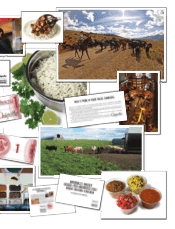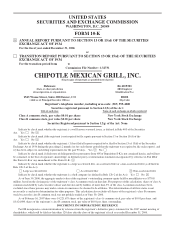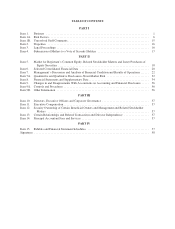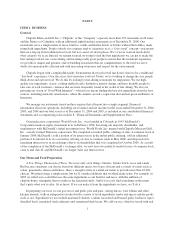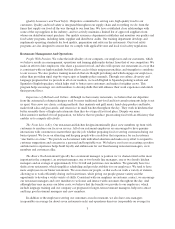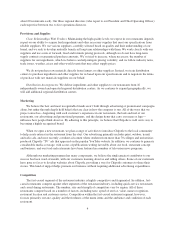Chipotle 2006 Annual Report Download - page 14
Download and view the complete annual report
Please find page 14 of the 2006 Chipotle annual report below. You can navigate through the pages in the report by either clicking on the pages listed below, or by using the keyword search tool below to find specific information within the annual report.rates achieved over the past several years. Our ability to operate new restaurants profitably and increase average
restaurant sales and comparable restaurant sales will depend on many factors, some of which are beyond our
control, including:
• executing our vision effectively;
• initial sales performance of new restaurants;
• competition, either from our competitors in the restaurant industry or our own restaurants;
• changes in consumer preferences and discretionary spending;
• consumer understanding and acceptance of the Chipotle experience;
• road construction and other factors limiting access to new restaurants;
• general economic conditions, which can affect restaurant traffic, local labor costs and prices we pay for
the ingredients and other supplies it uses; and
• changes in government regulation.
If we fail to open restaurants as quickly as planned or if new restaurants do not perform as planned, our
business and future prospects could be harmed. In addition, changes in our average restaurant sales or
comparable restaurant sales could cause our operating results to vary adversely from expectations, which could
cause the price of our common stock to fluctuate substantially.
Our expansion into new markets may present increased risks due to our unfamiliarity with those areas.
Some of our new restaurants are planned for markets where we have little or no operating experience. Those
markets may have different competitive conditions, consumer tastes and discretionary spending patterns than our
existing markets. As a result, those new restaurants may be less successful than restaurants in our existing
markets. Consumers in a new market may not be familiar with the Chipotle brand, and we may need to build
brand awareness in that market through greater investments in advertising and promotional activity than we
originally planned. We may find it more difficult in new markets to hire, motivate and keep qualified employees
who can project our vision, passion and culture. Restaurants opened in new markets may also have lower average
restaurant sales than restaurants opened in existing markets, and may have higher construction, occupancy or
operating costs than restaurants in existing markets. We may also have difficulty finding reliable suppliers or
distributors or ones that can provide us, either initially or over time, with adequate supplies of ingredients
meeting our quality standards. Sales at restaurants opened in new markets may take longer to ramp up and reach
expected sales and profit levels, and may never do so, thereby affecting our overall profitability.
Changes in food and supply costs could adversely affect our results of operations.
Our profitability depends in part on our ability to anticipate and react to changes in food and supply costs.
Any increase in the prices of the ingredients most critical to our menu, such as beef, chicken, cheese, avocados,
beans, tomatoes and pork, could adversely affect our operating results. Although we have risk management
strategies in place to mitigate the impact that these fluctuations have on our operating results, we, as all restaurant
companies, remain susceptible to increases in food costs as a result of factors beyond our control, such as general
economic conditions, seasonal fluctuations, weather conditions, demand, food safety concerns, generalized
infectious diseases, product recalls and government regulations. We are still assessing the impact of the recent
winter freeze in California and the southwestern U.S., but expect that we will see some resulting pressure on our
food costs. Additionally, due to increased demand for ethanol the cost of corn has increased substantially, which
may lead to inflationary pressures on corn-sourced ingredients including chicken and beef and could adversely
affect our food costs.
8


